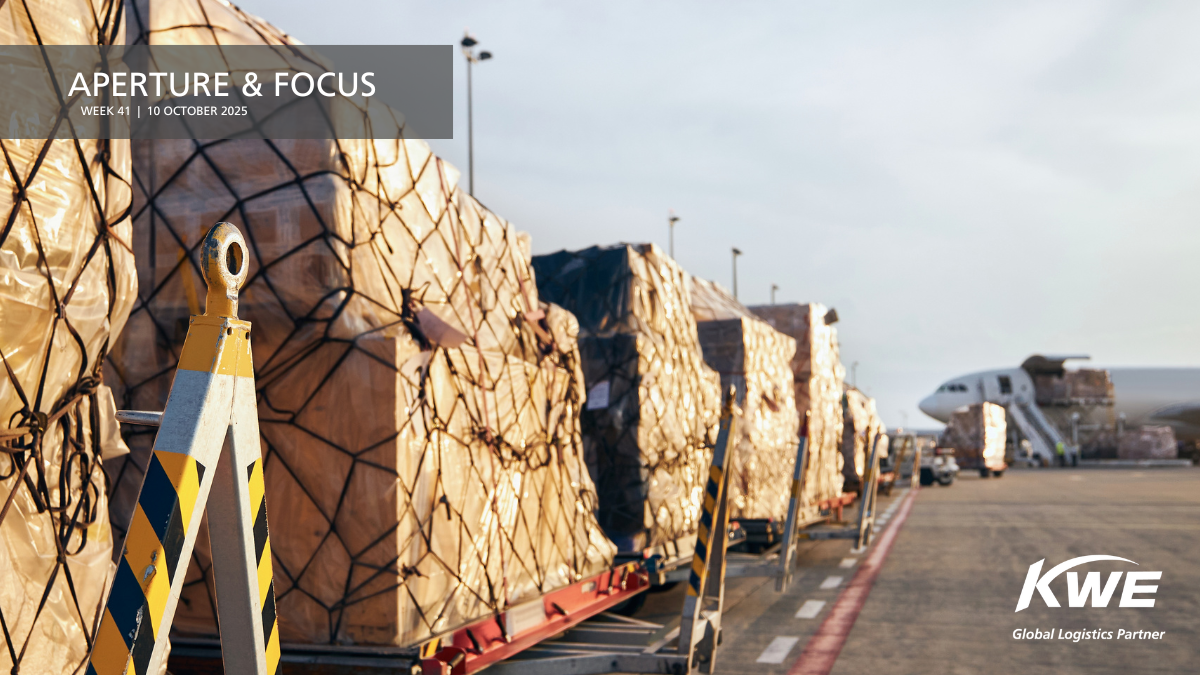Quote
Aperture & Focus 2025: Week 41

Global Aperture
Carriers have increased blank sailings on U.S.–China ocean routes to record levels as U.S. tariffs reduce shipping demand. Supply chain research platform Project44 reports there are currently 67 planned blank sailings from China to the U.S., with sharp increases on transpacific lanes as carriers adjust to weaker import demand.
The air cargo market grew just 3% year-on-year in September as new U.S. tariffs and the end of de minimis exemptions reshaped global trade flows. E-commerce and high-value shipments are shifting from North America to Europe and Asia, with Chinese exports to Europe up 58% year-to-date. While overall demand remains steady, weakened Transpacific volumes and shifting trade lanes reflect how geopolitical and policy changes continue to redefine global air cargo patterns.
Regional Focus
Americas
United States: The U.S. government shutdown that began October 1st has led to staffing shortages among air traffic controllers, causing flight delays at several major airports, though overall disruptions remain limited. The International Air Transport Association reported that global passenger and cargo demand remains strong.
U.S. President Donald Trump announced on October 6th that a 25% tariff on imported heavy- and medium-duty trucks will take effect on November 1st, revising the earlier start date from October. Mexico and Canada supply more than 90% of the trucks imported into the U.S., and analysts warn the tariffs could further pressure a freight market already facing weak demand, since imports account for nearly half of the nation’s heavy-truck supply.
U.S. Customs and Border Protection will begin imposing port fees on vessels built, owned, or operated by Chinese entities starting October 14th, a policy expected to cost the top 10 carriers about $3.2 billion over the next year. Beijing has warned it may impose reciprocal port fees and other restrictions on U.S. vessels.
Freight activity in the U.S. slowed sharply in September, a month that typically sees peak shipping volumes on Asia–U.S. cargo markets ahead of the holiday season. The latest Logistics Managers’ Index fell to 57.4, its lowest level since March 2025, as transportation utilization dropped to a neutral reading of 50.0, indicating stagnant movement of goods. Analysts attribute the downturn to front-loaded inventories, tighter warehouse capacity, and tariff-related distortions.
Asia-Pacific
China/Vietnam: Typhoon Matmo made landfall in southern China on October 5th, leading to the suspension of flights at Haikou Meilan International Airport (HAK) and the mass evacuation of parts of Guangdong Province, home to the Shenzhen and Hanjiang ports. As the storm moved west, its remnants brought heavy rainfall to northern Vietnam from October 6th to 8th, triggering floods that delayed flights at Noi Bai International Airport (HAN).
Cambodia: Phnom Penh’s new Techo International Airport (KTI) has officially begun operations. The airport is designed to handle up to 15 million passengers annually and offers new capacity for cargo operations in Southeast Asia.
Europe, Middle East & Africa
Netherlands: Container operations at the Port of Rotterdam have stagnated after dockworkers launched a 48-hour strike on October 8th. The walkout has halted vessel loading and unloading across major terminals, significantly extending laytimes and delaying schedules.
Belgium: Harbor pilots in Antwerp-Bruges have staged a protest from October 5th to 9th, reducing daily vessel movements by more than half. With Antwerp and Rotterdam ports disrupted simultaneously, carriers are warning of growing congestion risks and potential ripple effects across Northern Europe’s container.
Qatar: Hamad International Airport in Doha (DOH) in Doha and Shenzhen Bao’an International Airport (SZX) have signed a Sister Airport agreement to enhance cooperation in route planning, market analytics, and technology development. The partnership aims to strengthen passenger and cargo flows between China, the Middle East, and global marketsshipments.